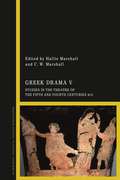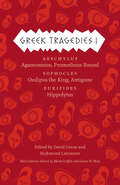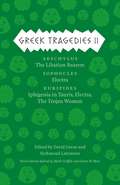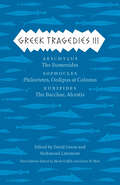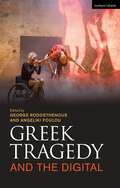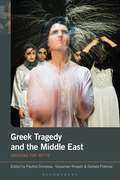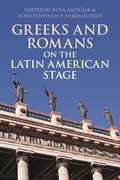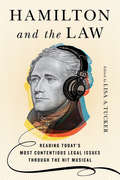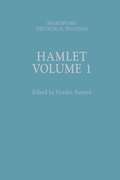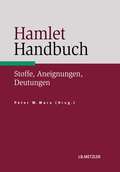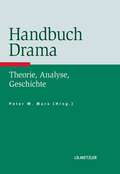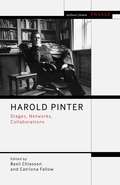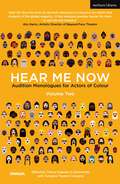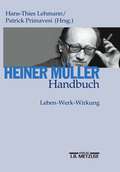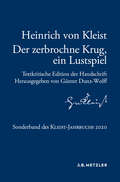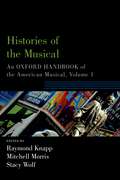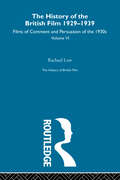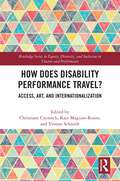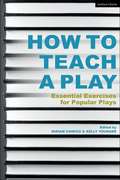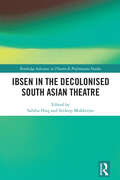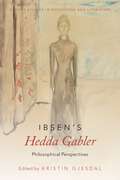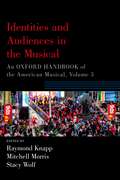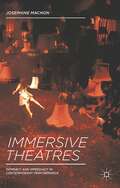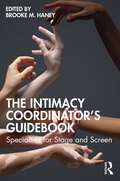- Table View
- List View
The Golden Thread: Irish Women Playwrights, Volume 1 (1716-1992)
This two-volume edited collection illuminates the valuable counter-canon of Irish women’s playwriting with forty-two essays written by leading and emerging Irish theatre scholars and practitioners. Covering three hundred years of Irish theatre history from 1716 to 2016, it is the most comprehensive study of plays written by Irish women to date. These short essays provide both a valuable introduction and innovative analysis of key playtexts, bringing renewed attention to scripts and writers that continue to be under-represented in theatre criticism and performance.Volume One covers plays by Irish women playwrights written between 1716 to 1992, and seeks to address and redress the historic absence of Irish female playwrights in theatre histories. Highlighting the work of nine women playwrights from the eighteenth and nineteenth centuries, as well as thirteen of the twentieth century’s key writers, the chapters in this volume explore such varied themes as the impact of space and place on identity, women’s strategic use of genre, and theatrical responses to shifts in Irish politics and culture.CONTRIBUTORS: Conrad Brunström, David Clare, Thomas Conway, Marguérite Corporaal, Mark Fitzgerald, Shirley-Anne Godfrey, Úna Kealy, Sonja Lawrenson, Cathy Leeney, Marc Mac Lochlainn, Kate McCarthy, Fiona McDonagh, Deirdre McFeely, Megan W. Minogue, Ciara Moloney, Justine Nakase, Patricia O'Beirne, Kevin O'Connor, Ciara O'Dowd, Clíona Ó Gallchoir, Anna Pilz, Emilie Pine, Ruud van den Beuken, Feargal Whelan
Greek Drama V: Studies in the Theatre of the Fifth and Fourth Centuries BCE
Drawing together new research from emerging and senior scholars, this selection of papers from the decennial Greek Drama V conference (Vancouver, 2017) explores the works of the ancient Greek playwrights and showcases new methodologies with which to study them. Sixteen chapters from a field of international contributors examine a range of topics, from the politics of the ancient theatre, to the role of the chorus, to the earliest history of the reception of Aeschylus' Oresteia. Employing anthropological, historical, and psychological critical methods alongside performance analysis and textual criticism, these studies bring fresh and original interpretations to the plays. Several contributions analyse fragmentary tragedies, while others incorporate ideas on the performance aspect of certain plays. The final chapters deal separately with comedy, naturally focusing on the plays of Aristophanes and Menander. Greek Drama V offers a window into where the academic field of Greek drama is now, and points towards the future scholarship it will produce.
Greek Tragedies 1: Aeschylus: Agamemnon, Prometheus Bound; Sophocles: Oedipus the King, Antigone; Euripides: Hippolytus
Greek Tragedies, Volume I contains Aeschylus’s “Agamemnon,” translated by Richmond Lattimore; Aeschylus’s “Prometheus Bound,” translated by David Grene; Sophocles’s “Oedipus the King,” translated by David Grene; Sophocles’s “Antigone,” translated by Elizabeth Wyckoff; and Euripides’s “Hippolytus,” translated by David Grene. Sixty years ago, the University of Chicago Press undertook a momentous project: a new translation of the Greek tragedies that would be the ultimate resource for teachers, students, and readers. They succeeded. Under the expert management of eminent classicists David Grene and Richmond Lattimore, those translations combined accuracy, poetic immediacy, and clarity of presentation to render the surviving masterpieces of Aeschylus, Sophocles, and Euripides in an English so lively and compelling that they remain the standard translations. Today, Chicago is taking pains to ensure that our Greek tragedies remain the leading English-language versions throughout the twenty-first century. In this highly anticipated third edition, Mark Griffith and Glenn W. Most have carefully updated the translations to bring them even closer to the ancient Greek while retaining the vibrancy for which our English versions are famous. This edition also includes brand-new translations of Euripides’ Medea, The Children of Heracles, Andromache, and Iphigenia among the Taurians, fragments of lost plays by Aeschylus, and the surviving portion of Sophocles’s satyr-drama The Trackers. New introductions for each play offer essential information about its first production, plot, and reception in antiquity and beyond. In addition, each volume includes an introduction to the life and work of its tragedian, as well as notes addressing textual uncertainties and a glossary of names and places mentioned in the plays. In addition to the new content, the volumes have been reorganized both within and between volumes to reflect the most up-to-date scholarship on the order in which the plays were originally written. The result is a set of handsome paperbacks destined to introduce new generations of readers to these foundational works of Western drama, art, and life.
Greek Tragedies 2: Aeschylus: The Libation Bearers; Sophocles: Electra; Euripides: Iphigenia among the Taurians, Electra, The Trojan Women
Greek Tragedies, Volume II contains Aeschylus’s “The Libation Bearers,” translated by Richmond Lattimore; Sophocles’s “Electra,” translated by David Grene; Euripides’s “Iphigenia among the Taurians,” translated by Anne Carson; Euripides’s “Electra,” translated by Emily Townsend Vermeule; and Euripides’s “The Trojan Women,” translated by Richmond Lattimore. Sixty years ago, the University of Chicago Press undertook a momentous project: a new translation of the Greek tragedies that would be the ultimate resource for teachers, students, and readers. They succeeded. Under the expert management of eminent classicists David Grene and Richmond Lattimore, those translations combined accuracy, poetic immediacy, and clarity of presentation to render the surviving masterpieces of Aeschylus, Sophocles, and Euripides in an English so lively and compelling that they remain the standard translations. Today, Chicago is taking pains to ensure that our Greek tragedies remain the leading English-language versions throughout the twenty-first century. In this highly anticipated third edition, Mark Griffith and Glenn W. Most have carefully updated the translations to bring them even closer to the ancient Greek while retaining the vibrancy for which our English versions are famous. This edition also includes brand-new translations of Euripides’ Medea, The Children of Heracles, Andromache, and Iphigenia among the Taurians, fragments of lost plays by Aeschylus, and the surviving portion of Sophocles’s satyr-drama The Trackers. New introductions for each play offer essential information about its first production, plot, and reception in antiquity and beyond. In addition, each volume includes an introduction to the life and work of its tragedian, as well as notes addressing textual uncertainties and a glossary of names and places mentioned in the plays. In addition to the new content, the volumes have been reorganized both within and between volumes to reflect the most up-to-date scholarship on the order in which the plays were originally written. The result is a set of handsome paperbacks destined to introduce new generations of readers to these foundational works of Western drama, art, and life.
Greek Tragedies 3: Aeschylus: The Eumenides; Sophocles: Philoctetes, Oedipus at Colonus; Euripides: The Bacchae, Alcestis
Greek Tragedies, Volume III contains Aeschylus’s “The Eumenides,” translated by Richmond Lattimore; Sophocles’s “Philoctetes,” translated by David Grene; Sophocles’s “Oedipus at Colonus,” translated by Robert Fitzgerald; Euripides’s “The Bacchae,” translated by William Arrowsmith; and Euripides’s “Alecestis,” translated by Richmond Lattimore. Sixty years ago, the University of Chicago Press undertook a momentous project: a new translation of the Greek tragedies that would be the ultimate resource for teachers, students, and readers. They succeeded. Under the expert management of eminent classicists David Grene and Richmond Lattimore, those translations combined accuracy, poetic immediacy, and clarity of presentation to render the surviving masterpieces of Aeschylus, Sophocles, and Euripides in an English so lively and compelling that they remain the standard translations. Today, Chicago is taking pains to ensure that our Greek tragedies remain the leading English-language versions throughout the twenty-first century. In this highly anticipated third edition, Mark Griffith and Glenn W. Most have carefully updated the translations to bring them even closer to the ancient Greek while retaining the vibrancy for which our English versions are famous. This edition also includes brand-new translations of Euripides’ Medea, The Children of Heracles, Andromache, and Iphigenia among the Taurians, fragments of lost plays by Aeschylus, and the surviving portion of Sophocles’s satyr-drama The Trackers. New introductions for each play offer essential information about its first production, plot, and reception in antiquity and beyond. In addition, each volume includes an introduction to the life and work of its tragedian, as well as notes addressing textual uncertainties and a glossary of names and places mentioned in the plays. In addition to the new content, the volumes have been reorganized both within and between volumes to reflect the most up-to-date scholarship on the order in which the plays were originally written. The result is a set of handsome paperbacks destined to introduce new generations of readers to these foundational works of Western drama, art, and life.
Greek Tragedy and the Digital
Adopting an innovative and theoretical approach, Greek Tragedy and the Digital is an original study of the encounter between Greek tragedy and digital media in contemporary performance. It challenges Greek tragedy conventions through the contemporary arsenal of sound masks, avatars, live code poetry, new media art and digital cognitive experimentations. These technological innovations in performances of Greek tragedy shed new light on contemporary transformations and adaptations of classical myths, while raising emerging questions about how augmented reality works within interactive and immersive environments. Drawing on cutting-edge productions and theoretical debates on performance and the digital, this collection considers issues including performativity, liveness, immersion, intermediality, aesthetics, technological fragmentation, conventions of the chorus, theatre as hypermedia and reception theory in relation to Greek tragedy. Case studies include Kzryztof Warlikowski, Jan Fabre, Romeo Castellucci, Katie Mitchell, Georges Lavaudant, The Wooster Group, Labex Arts-H2H, Akram Khan, Urland & Crew, Medea Electronique, Robert Wilson, Klaus Obermaier, Guy Cassiers, Luca di Fusco, Ivo Van Hove, Avra Sidiropoulou and Jay Scheib. This is an incisive, interdisciplinary study that serves as a practice model for conceptualizing the ways in which Greek tragedy encounters digital culture in contemporary performance.
Greek Tragedy and the Middle East: Chasing the Myth (Classical Diaspora)
Employing the idea of interculturality to study Middle Eastern adaptations of Greek tragedy from the turn of 20th century until the present day, this book first explores the earlier phase of the development of Greek classical reception in Middle Eastern theatre. It then moves to focus on modern Arabic, Persian and Turkish adaptations of Greek tragedy both in the early post-colonial and contemporary periods in the MENA and in Europe. Case by case, this book examines how the classical sources are reworked and adapted, as well as how they engage with interculturality, hybridisation and the circulation of aesthetics and models. At the same time, it explores the implications and consequences of expressing socio-political concerns through classical Greek sources. While Muslim thinkers and translators introduced Greek philosophy – in particular Aristotle's Poetics – to the West in the Middle Ages, adaptations of Greek tragedies only appeared in the MENA region at the very beginning of the 20th century. For this reason, the development of Greek tragedy in the Middle East is difficult to disentangle from colonialism and cultural imperialism. Encompassing language differences and offering for the first time a broad approach on the Middle-Eastern reception of Greek tragedy, this book produces a renewed focus on a fascinating aspect of the classical tradition.
Greeks and Romans on the Latin American Stage (Bloomsbury Studies in Classical Reception)
The first comprehensive treatment in English of the rich and varied afterlife of classical drama across Latin America, this volume explores the myriad ways in which ancient Greek and Roman texts have been adapted, invoked and re-worked in notable modern theatrical works across North and South America and the Caribbean, while also paying particular attention to the national and local context of each play.A comprehensive introduction provides a critical overview of the varying issues and complexities that arise when studying the afterlife of the European classics in the theatrical stages across this diverse and vast region. Fourteen chapters, divided into three general geographical sub-regions (Southern Cone, Brazil and the Caribbean and North America) present a strong connection to an ancient dramatic source text as well as comment upon important socio-political crises in the modern history of Latin America. The diversity and expertise of the voices in this volume translate into a multi-ranging approach to the topic that encompasses a variety of theoretical and interdisciplinary perspectives from classics, Latin American studies and theatre and performance studies.
Hamilton and the Law: Reading Today's Most Contentious Legal Issues through the Hit Musical
Since its Broadway debut, Hamilton: An American Musical has infused itself into the American experience: who shapes it, who owns it, who can rap it best. Lawyers and legal scholars, recognizing the way the musical speaks to some of our most complicated constitutional issues, have embraced Alexander Hamilton as the trendiest historical face in American civics. Hamilton and the Law offers a revealing look into the legal community's response to the musical, which continues to resonate in a country still deeply divided about the reach of the law. A star-powered cast of legal minds—from two former U.S. solicitors general to leading commentators on culture and society—contribute brief and engaging magazine-style articles to this lively book. Intellectual property scholars share their thoughts on Hamilton's inventive use of other sources, while family law scholars explore domestic violence. Critical race experts consider how Hamilton furthers our understanding of law and race, while authorities on the Second Amendment discuss the language of the Constitution's most contested passage. Legal scholars moonlighting as musicians discuss how the musical lifts history and law out of dusty archives and onto the public stage. This collection of minds, inspired by the phenomenon of the musical and the Constitutional Convention of 1787, urges us to heed Lin-Manuel Miranda and the Founding Fathers and to create something new, daring, and different.
Hamlet: Shakespeare: The Critical Tradition, Volume 1 (Shakespeare: The Critical Tradition)
Hamlet is one of Shakespeare's four great tragedies, studied and performed around the world. This new volume in Shakespeare: The Critical Tradition increases our knowledge of how Shakespeare's plays were received and understood by critics, editors and general readers. It traces the course of Hamlet criticism, from the earliest items of recorded criticism to the latter half of the Victorian period. The focus of the documentary material is from the late 18th century to the late 19th century. Thus the volume makes a major contribution to our understanding of the play and of the traditions of Shakespearean criticism surrounding it as they have developed from century to century. The introduction constitutes an important chapter of literary history, tracing the entire critical career of Hamlet from the beginnings to the present day.The volume features criticism from leading literary figures, such as Henry James, Anna Jameson, Victor Hugo, Thomas Carlyle, Samuel Taylor Coleridge and Mary Cowden Clarke. The chronological arrangement of the text-excerpts engages the readers in a direct and unbiased dialogue, whereas the introduction offers a critical evaluation from a current stance, including modern theories and methods. Thus the volume makes a major contribution to our understanding of the play and of the traditions of Shakespearean criticism surrounding it as they have developed from century to century.
Hamlet-Handbuch: Stoffe, Aneignungen, Deutungen
Moderne mythische Gestalt und Kernbestand des kulturellen Kanons. Kaum eine Figur beherrscht so sehr die westliche Vorstellung vom Theater wie Shakespeares Hamlet. Das Handbuch beschäftigt sich mit dem Hamlet-Stoff und seiner Deutung und vermittelt Hintergrundwissen zum Shakespeareschen Drama. Der Schwerpunkt liegt auf der vielgestaltigen Rezeptionsgeschichte. Sowohl die Bühnengeschichte als auch die Aneignungen der Figur in Kunst, Literatur, Musik, Film und Populärkultur werden ausführlich beleuchtet. Mit vielen Beispielen, teilweise in englischer Sprache.
Handbuch Drama: Theorie, Analyse, Geschichte
Das Genre des Dramas in der Gesamtschau. Das Handbuch präsentiert die zentralen Formen und Konzeptionen des Dramas und liefert einen Überblick über den aktuellen Stand der literatur- und theaterwissenschaftlichen Forschung aus komparatistischer Perspektive. Wichtige Begriffe der Dramentheorie werden ebenso erläutert wie die wesentlichen Modelle der Dramenanalyse. Indem es auch die Einflüsse auf das Theater untersucht, trägt das Werk der Sonderstellung Rechnung, die das Drama innerhalb der klassischen Gattungstheorie einnimmt.
Harold Pinter: Stages, Networks, Collaborations (Methuen Drama Engage)
This important book offers a thematic collection of critical essays, ideal for undergraduate courses on modern British theatre, on Harold Pinter's theatrical works, alongside new interviews with contemporary theatre practitioners. The life and works of Harold Pinter (1930–2008), a pivotal figure in British theatre, have been widely discussed, debated and celebrated internationally. For over five decades, Pinter's work traversed and redefined various forms and genres, constantly in dialogue with, and often impacting the work of, other writers, artists and activists. Combining a reconsideration of key Pinter scholarship with new contexts, voices and theoretical approaches, this book opens up fresh insights into the author's work, politics, collaborations and his enduring status as one of the world's foremost dramatists. Three sections re-contextualize Pinter as a cultural figure; explore and interrogate his influence on contemporary British playwriting; and offer a series of original interviews with theatre-makers engaging in the staging of Pinter's work today. Reconsiderations of Pinter's relationship to literary and theatrical movements such as Modernism and the Theatre of the Absurd; interrogations of the role of class, elitism and religious and cultural identity sit alongside chapters on Pinter's personal politics, specifically in relation to the Middle East.
Hear Me Now, Volume Two: Audition Monologues for Actors of Colour (Audition Speeches)
Hear Me Now, Volume Two is a unique collection of over 80 original audition monologues, expressly created by a range of writers including Vera Chok, Josh-Susan Enright and Bea Webster, brought together by producer Titilola Dawudu and Tamasha Theatre Company. They are ideal for actors of colour searching for speeches for auditions or training, writers, teachers, and theatre-makers who are passionate about improving diversity.The volume is introduced by BAFTA-nominated actor Ashley Madekwe, and will also feature a section on Top Tips for auditioning from Tamasha Theatre and a host of actors, including Ted Lasso's Kevin 'KG' Garry and Cherrelle Skeete of Harry Potter and the Cursed Child.Following on from the successful first volume, and featuring a variety of themes, scenes and characters, Hear Me Now, Volume Two is an essential tool for actors of colour to showcase their range, and seeks to inspire, empower, and create a legacy for generations to come.
Heiner Müller-Handbuch: Leben – Werk – Wirkung
Heiner Müller (1929-1995) gilt als der wichtigste deutsche Theaterautor seit Brecht. Der vorliegende Band gibt einen umfassenden Überblick über das Gesamtwerk. Über die Werkanalysen hinaus lassen die Autoren auch grundlegenden Aspekten, dem Verhältnis zur Tradition und den Stellungnahmen Müllers zum Zeitgeschehen, genügend Raum. Auf diese Weise kommt die Vielfalt von Müllers eigener Produktion ebenso zum Tragen wie die thematisch und motivisch übergreifenden Momente. Der Leser bekommt eine Vorstellung von Voraussetzungen und Wirkungen seines Schaffens und der Bedeutung von Müllers Positionen und Reflexionen zu politischen und ästhetischen Problemen. Eine detaillierte Bibliografie rundet den Band ab.
Heinrich von Kleist: Textkritische Edition der Handschrift. Sonderband des Kleist-Jahrbuchs 2020
Mit dieser Edition von Kleists Handschrift »Der zerbrochne Krug« wird eine textgenetische Darstellung vorgelegt, die Kleists zahlreiche, teilweise komplexen Textänderungen en detail rekonstruiert. Methodisches Instrumentarium für die Rekonstruktion bildet die Handschriftanalyse. Wesentliches Ergebnis der Rekonstruktion ist die chronologische Darstellung der einzelnen Versvarianten und ihrer versübergreifenden Bezüge. Sofern die Versfassungen sich unterscheiden, werden auch die Fassungen der »Phöbus«Fragmente und des Erstdrucks mitgeteilt. Auf diesem Weg entsteht ein komplexes Bild der zahlreichen Übereinstimmungen und Abweichungen der unterschiedlichen »Krug«-Textzeugen, deren dichtes Beziehungsgeflecht hier erstmals systematisch und vollständig erfassbar ist. Abgeschlossen wird der Band mit einer Untersuchung zur Entwicklung von Kleists Handschrift, deren Methodik diese Edition erst ermöglicht hat. Die Darstellung wird unterstützt durch den Abdruck zahlreicher Faksimile-Ausschnitte. Die Edition erscheint als Sonderband des Kleist-Jahrbuchs.
Histories of the Musical: An Oxford Handbook of the American Musical, Volume 1 (Oxford Handbooks)
The American musical is a paradox. On stage or screen, musicals at once hold a dominant and a contested place in the worlds of entertainment, art, and scholarship. Born from a mélange of performance forms that included opera and operetta, vaudeville and burlesque, minstrelsy and jazz, musicals have always sought to amuse more than instruct, and to make money more than make political change. In spite of their unapologetic commercialism, though, musicals have achieved supreme artistry and have influenced culture as much as if not more than any other art form in America, including avant-garde and high art on the one hand, and the full range of popular and commercial art on the other. Reflecting, refracting, and shaping U.S. culture since the early twentieth century, musicals converse with shifting dynamics of gender and sexuality, ethnicity and race, and the very question of what it means to be American and to be human. The chapters gathered in this book, Volume I of the reissued Oxford Handbook, explore the American musical from both the outside and the inside. This first volume concentrates in particular on large-scale, more philosophical issues of relevance to the genre, considering issues of historical situations and formal procedure as they bear on the narratives we make concerning productions and performers, artists and audiences, commerce and context. The first four essays discuss ways of defining histories and texts, and apprehending the formal choices of singers and dancers; the second group of four take up the subtle challenges of the genre's signal transformations out of minstrelsy and Tin Pan Alley to "integration" and beyond.
The History of British Film (Volume 6): The History of the British Film 1929 - 1939: Films of Comment and Persuasion of the 1930's
This set is one of the cornerstones of film scholarship, and one of the most important works on twentieth century British culture. Published between 1948 and 1985, the volumes document all aspects of film making in Britain from its origins in 1896 to 1939.Rachael Low pioneered the interpretation of films in their context, arguing that to understand films it was necessary to establish their context. Her seven volumes are an object lesson in meticulous research, lucid analysis and accessible style, and have become the benchmark in film history.
How Does Disability Performance Travel?: Access, Art, and Internationalization (Routledge Series in Equity, Diversity, and Inclusion in Theatre and Performance)
This edited collection investigates the myriad ways in which disability performance travels in a globalized world. Disability arts festivals are growing in different parts of the world; theatre and dance companies with disabled artists are increasingly touring and collaborating with international partners. At the same time, theatre spaces are often not accessible, and the necessity of mobility excludes some disabled artists from being part of an international disability arts community. How does disability performance travel, who does not travel – and why? What is the role of funding and producing structures, disability arts festivals and networks around the world? How do the logics of international (co-)producing govern the way in which disability art is represented internationally? Who is excluded from being part of a touring theatre or dance company, and how can festivals, conferences, and other agents of a growing disability culture create other forms of participation, which are not limited to physical co-presence? This study will contextualize disability aesthetics, arts, media, and culture in a global frame, yet firmly rooted in its smaller national, state, and local community settings and will be of great interest to students and scholars in the field.
How to Teach a Play: Essential Exercises for Popular Plays
Most students encounter drama as they do poetry and fiction – as literature to be read – but never experience the performative nature of theater. How to Teach a Play provides new strategies for teaching dramatic literature and offers practical, play-specific exercises that demonstrate how performance illuminates close reading of the text. This practical guide provides a new generation of teachers and theatre professionals the tools to develop their students' performative imagination. Featuring more than 80 exercises, How to Teach a Play provides teaching strategies for the most commonly taught plays, ranging from classical through contemporary drama. Developed by contributors from a range of disciplines, these exercises reveal the variety of practitioners that make up the theatrical arts; they are written by playwrights, theater directors, and artistic directors, as well as by dramaturgs and drama scholars. In bringing together so many different perspectives, this book highlights the distinctive qualities that makes theater such a dynamic genre. This collection offers an array of proven approaches for anyone teaching drama: literature and theater professors; high school teachers; dramaturgs and directors. Written in an accessible and jargon-free style, both instructors and directors can immediately apply the activity to the classroom or rehearsal. Whether you specialize in drama or only teach a play every now and again, these exercises will inspire you to modify, transform, and reinvent your own role in the dramatic arts.Online resources to accompany this book are available at:https://www.bloomsbury.com/how-to-teach-a-play-9781350017528/.
Ibsen in the Decolonised South Asian Theatre (Routledge Advances in Theatre & Performance Studies)
This book maps South Asian theatre productions that have contextualised Ibsen’s plays to underscore the emergent challenges of postcolonial nation formation. The concerns addressed in this collection include politico-cultural engagements with human rights, economic and environmental issues, and globalisation, all of which have evolved through colonial times and thereafter. This book contemplates why and how these Ibsen texts were repeatedly adapted for the stage and consequently reflects upon the political intent of this appropriative journey of the foreign playwright. This book tracks the unmapped agency that South Asian theatre has acquired through aesthetic appropriation of Ibsen and thereby contributes to his global reception. This collection will be of great interest to students and scholars of theatre and performance studies.
Ibsen's Hedda Gabler: Philosophical Perspectives (Oxford Studies in Philosophy and Lit)
Since its publication in 1890, Ibsen's Hedda Gabler has been a recurring point of fascination for readers, theater audiences, and artists alike. Newly married, yet utterly bored, the character of Hedda Gabler evokes reflection on beauty, love, passion, death, nihilism, identity, and a host of other topics of an existential nature. It is no surprise that Ibsen's work has gained the attention of philosophically-minded readers from Nietzsche, Lou Andreas-Salomé, and Freud, to Adorno, Cavell, and beyond. Once staged at avant-garde theaters in Paris, London, and Berlin, Ibsen is now a global phenomenon. The enigmatic character of Hedda Gabler remains intriguing to ever-new generations of actors, audiences, and readers. Hedda Gabler occupies a privileged place in the history of European drama and as a work of literature, and, as this volume demonstrates, invites profound and worthwhile philosophical questions. Through ten newly commissioned chapters, written by leading voices in the fields of drama studies, European philosophy, Scandinavian studies, and comparative literature, this volume brings out the philosophical resonances of Hedda Gabler in particular and Ibsen's drama more broadly.
Identities and Audiences in the Musical: An Oxford Handbook of the American Musical, Volume 3 (Oxford Handbooks)
Issues of identity have always been central to the American musical in all its guises. Who appears in musicals, who or what they are meant to represent, and how, over time, those representations have been understood and interpreted, provide the very basis for our engagement with the genre. In this third volume of the reissued Oxford Handbook of the American Musical, chapters focus on race, ethnicity, gender, and sexuality, regional vs. national identity, and the cultural and class significance of the musical itself. As important as the question of who appears in musicals are the questions of who watches and listens to them, and of how specific cultures of reception attend differently to the musical. Chapters thus address cultural codes inherent to the genre, in particular those found in traditional school theater programs.
Immersive Theatres: Intimacy and Immediacy in Contemporary Performance
This comprehensive text is the first survey to explore the theory, history and practice of immersive theatre. Charting the rise of the immersive theatre phenomenon, Josephine Machon shares her wealth of expertise in the field of contemporary performance, inviting the reader to immerse themselves within this abundantly illustrated text. The first section of the book introduces concepts of immersion, situating them within a historical context and establishing a clear critical vocabulary for discussion. The second section then presents contributions from a wealth of immersive artists. Assuming no prior knowledge with its critical commentary, this is a rich resource for lecturers and students at all levels and internationally, including undergraduates and post-graduates, as well as practitioners and researchers of contemporary performance. This would also be an ideal text for general enthusiasts and readers with an interest in immersive theatre.
The Intimacy Coordinator's Guidebook: Specialties for Stage and Screen
The Intimacy Coordinator's Guidebook: Specialties for Stage and Screen explores the role of the intimacy choreographer with an in-depth look at specializations that exist within the profession.With contributions by over 30 industry professionals, this book aims to bring awareness to a wide range of needs a project may have and how intimacy professionals use their cultural competency specialists in practice to create the most compelling storytelling. In Part One, the book addresses the scope of practice of an intimacy professional by discussing competency, finding your lens and tangential fields in the industry like fight directors, mental health coordinators and cultural competency specialists. Part Two covers specialties like working with minors, prosthetics, intimacy and disability, staging queer intimacy, working with fat actors, Black American intimacy, dance, working on scenes of trauma, sexual violence and non-consent, and BDSM. Between each chapter is a conversation with an actor, director or producer on their experiences working with an intimacy coordinator. In Part Three, the book looks at what it means to be qualified and intimacy professionals' hopes for the future of the industry.The Intimacy Coordinator's Guidebook is an invaluable resource for directors and producers looking to hire an intimacy professional, as well as in-depth study for those who are training or practicing in the field of intimacy for performance.

